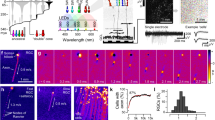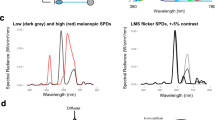Abstract
Light adaptation is the adjustment of retinal response properties to variations in ambient illumination. It enables the encoding of visual information over a millionfold intensity range, from moonlight to broad daylight, despite the relatively small dynamic range of response of visual neurones. We have studied the effects of light adaptation on the dynamics and sensitivity of visual responses of neurones in the turtle retina, by measuring the responses of horizontal cells in the retina to light which was modulated with a sinusoidal time course around various mean levels. As a quantitative measure of the transduction from light to neural signals, we calculated the gain of response at each frequency. Gain is defined as the amplitude of the modulated response component divided by the amplitude of light modulation. We report here that the gain (mV photon−1) at low temporal frequencies decreased as the mean light level increased. Over a 2 log-unit range of mean light levels, low-frequency gain was inversely proportional to the mean light level, as in Weber's law. However, at high temporal frequencies, the gain was almost independent of mean light level. Our results are reminiscent of Kelly's1 results on human temporal-frequency sensitivity in various states of light adaptation. We found that a family of horizontal-cell temporal frequency responses, measured at various mean light levels, could be accounted for by a negative feedback model in which the feedback strength is proportional to mean light level.
This is a preview of subscription content, access via your institution
Access options
Subscribe to this journal
Receive 51 print issues and online access
$199.00 per year
only $3.90 per issue
Buy this article
- Purchase on Springer Link
- Instant access to full article PDF
Prices may be subject to local taxes which are calculated during checkout
Similar content being viewed by others
References
Kelly, D. H. J. opt. Soc. Am. 51, 747–754 (1961); 61, 537–546 (1971).
Shapley, R. M. & Enroth-Cugell, C. in Progress in Retinal Research (eds Osborne, N. & Chader, G.) (Pergamon, London, 1984).
Baylor, D. A. & Hodgkin, A. L. J. Physiol., Lond. 242, 729–758 (1974).
Normann, R. A. & Perlman, I. J. Physiol., Lond. 286, 491–508 (1979).
Simon, E. J. J. Physiol., Lond. 230, 199–211 (1973).
Fuortes, M. G. F. & Simon, E. J. J. Physiol, Lond. 240, 177–198 (1974).
Yazulla, S. Vision Res. 16, 727–735 (1976).
Perlman, I. & Normann, R. A. Vision Res. 19, 903–906 (1979).
Fuortes, M. G. F., Schwartz, E. A. & Simon, E. J. J. Physiol., Lond. 234, 199–216 (1973).
Baylor, D. A., Fuortes, M. G. F. & O'Bryan, P. M. J. Physiol., Lond. 214, 265–294 (1971).
O'Bryan, P. M. J. Physiol., Lond. 235, 207–223 (1973).
Tranchina, D., Gordon, J., Shapley, R. & Toyoda, J.-I. Proc. natn. Acad. Sci. U.S.A. 78, 6540–6542 (1981).
Naka, K.-I., Sakuranaga, M. & Chappell, R. L. Biomed. Res. 3, Suppl., 131–136 (1982).
Tranchina, D., Gordon, J. & Shapley, R. J. gen. Physiol. 82, 573–598 (1983).
Baylor, D. A., Hodgkin, A. L. & Lamb, T. D. J. Physiol, Lond. 242, 759–791 (1974).
Chappell, R. L., Sakuranaga, M. & Naka, K.-I. Neurosci. Abstr. 9, 687 (1983).
Author information
Authors and Affiliations
Rights and permissions
About this article
Cite this article
Tranchina, D., Gordon, J. & Shapley, R. Retinal light adaptation—evidence for a feedback mechanism. Nature 310, 314–316 (1984). https://doi.org/10.1038/310314a0
Received:
Accepted:
Issue Date:
DOI: https://doi.org/10.1038/310314a0
This article is cited by
-
Spatiotemporal Kernel of a Three-Component Differential Equation Model with Self-control Mechanism in Vision
Journal of Mathematical Imaging and Vision (2023)
-
Origin and effect of phototransduction noise in primate cone photoreceptors
Nature Neuroscience (2013)
-
Light adaptation in cone vision involves switching between receptor and post-receptor sites
Nature (2007)
-
Independence of luminance and contrast in natural scenes and in the early visual system
Nature Neuroscience (2005)
-
Simulated bipolar cells in fovea of human retina
Biological Cybernetics (1991)
Comments
By submitting a comment you agree to abide by our Terms and Community Guidelines. If you find something abusive or that does not comply with our terms or guidelines please flag it as inappropriate.



